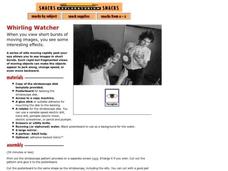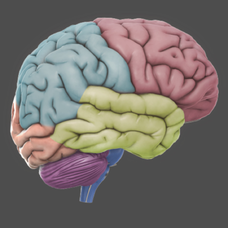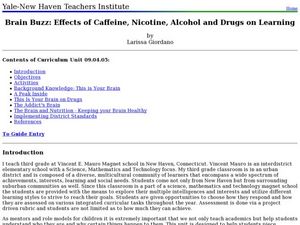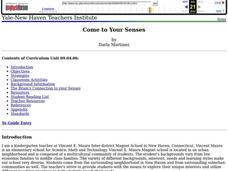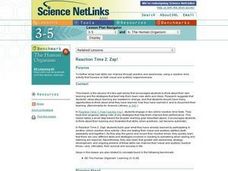Exploratorium
Jacques Cousteau in Seashells
Visionaries create images out of dots to demonstrate the eye-brain connection. Through this activity, they learn that the brain interprets data collected by the eye into recognizable information. Search online for "Jacques Cousteau in...
Baylor College
Neural Network Signals
Using a simple circuit with the battery representing the brain, future physiologists test to see which solutions conduct electrical "nerve impulses." Enlighten learners with plentiful information on electric signals in the nervous system...
Baylor College
Pre-Assessment: The Brain
Break your class in to the general structure and function of the brain. Brainiacs discuss what they know about it and create personalized brain development timelines. They also take a true-false, pre-assessment quiz to get them thinking...
Baylor College
Crossing the Synaptic Gap
As part of a unit on the chemistry of the brain, thinkers learn how chemicals work to transmit messages between individual neurons and how controlled substances impact the synaptic cleft. They do so by playing a dice-and-card game in...
Scholastic
Study Jams! The Nervous System
Get your class thinking with animations of neurons in action and explanations of how stimuli is transported and processed. This film makes an ideal introduction or review of the nervous system. The parts of the brain and what they...
Curated OER
Brain Breaks to Liven Up the School Day!
Short brain breaks increase engagement and encourage teamwork in elementary, middle school, and even high school classrooms.
Curated OER
The Nervous System
Human biology beginners label colorful diagrams of the neuron, the reflex pathway, and the brain. They list steps in the action potential process, and describe several different neurotransmitters. This worksheet guides learners through...
Exploratorium
Whirling Watcher
Pupils put together their own stroboscopes so that they can observe how cyclically moving images appear to merge into a singular object. This, and several other activities published by the same source, illuminate the way the brain...
Baylor College
Food for the Brain
With a couple of neat diagrams on student handouts, your life science or health class will examine the contents and serving sizes of healthy foods. They dissect a slice of pizza and scrutinize the nutritional value of its components in...
Cold Spring Harbor Laboratory
3D Brain
Imagine being able to rotate the brain and view interior structures without dissection! This tool allows anatomy masters to do just that. They also learn about the associated functions, disorders, and symptoms of damage to each structure.
Curated OER
AP: Chapter 48: Nervous System
Human anatomy enthusiasts trace neurological pahtways in word and on a diagram, describe action potential of a nerve impulse, and identify the organs in the nervous system. Provide this to your biology class as a review before...
Curated OER
Autism And The Brain
Help your class understand Autism. They conduct research into how the brain is effected by the disorder of autism. Then they write a letter to the Center For Disease Control about their findings and forward some of the new research to them.
Curated OER
Cranial Nerves
This page consists of a list of the cranial nerves in triplicate. The diagram of the brain that tops each copy of the list is too small for identifying each nerve. Consider giving your avid anatomists one of these lists with a large...
Curated OER
Nervous System
Are you nervous about teaching the nervous system to your beginning biologists? Worry no more! This PowerPoint provides a note-taking guide and diagrams of the neuron and the brain. Viewers will walk away with a clear understanding of...
Curated OER
Brain-Controlled Robotic Arms: Cloze activity with Article
Fascinating content about current medical research on brain-controlled prosthetics comes in cloze activity form with a link to the original article. Useful for listening and reading comprehension skills development, and for any science...
Curated OER
Brain Buzz: Effects of Caffeine, Nicotine, Alcohol and Drugs on Learning
Students understand how the brain functions and how they can promote a healthy lifestyle. In this health lesson students complete several activities including investigating how stimulates affect the brain.
Curated OER
Teaching Neuro-anatomy Through Schematic Diagrams
High schoolers develop a deeper understanding of the brain. In this neuro-anatomyl lesson plan, students will use simple diagrams to understand the brain and will progress to more complex diagrams as they gain understanding.
Curated OER
How the Brain Learns
Students identify the basic function of the lobes in the brain. In this memory lesson students complete a lab activity on how fast they can react.
Curated OER
Come to Your Senses
Students explore their senses. For this biology lesson plan, students will learn about their senses, what affects them, and how the brain works to control our senses in a series of lab activities.
Curated OER
Reaction Time 2: Zap!
Students explore critical thinking by conducting a reaction time experiment. For this human brain lesson, students utilize a timed Internet worksheet activity to research how fast their brain works when answering questions. Students...
Curated OER
The Busy Brain
Students explore biology by completing a human body worksheet. In this human brain instructional activity, students identify the different anatomy within the brain and the functions those pieces form. Students read an article about...
Curated OER
The Nervous System
Students investigate the nervous system. In this anatomy activity, students identify and define vocabulary related to the nervous system. Students role play the parts of a nervous system and perform an experiment measuring and comparing...
Curated OER
Perception and the Brain
Students experience how the brain adapts over time to changes in what they perceive. In this human perception lesson, students wear special prism goggles that initially disorient the user. Over time, the student is able to adjust to the...
Curated OER
GED Vocabulary: Life Science
In this life science GED learning exercise, students complete a crossword puzzle given 9 clues about structures of the nervous system, the circulatory system, evolution, the digestive system, molecules and fossils. Students are given a...









